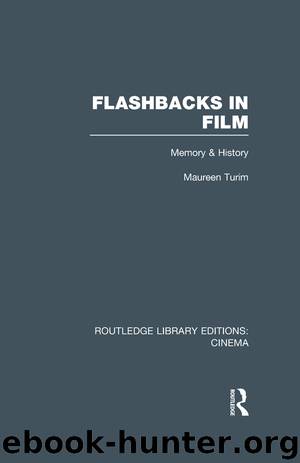Flashbacks in Film by Turim Maureen Cheryn

Author:Turim, Maureen Cheryn
Language: eng
Format: epub
ISBN: 9781317916666
Publisher: Taylor & Francis (CAM)
5
Flashbacks and the Psyche in Melodrama and Film Noir
Besides subjectivizing history, another major tendency in flashbacks in American films of the forties and fifties is to bind flashback structure to the psyche, either overtly, as is the case in the psychological melodrama, or covertly, as is the case in film noir, the stylized detective/crime film that emerged in this period. In both cases, the films’ hermeneutic structures entail investigation or confession. The secrets of the past need to be told or found out.
The two structures overlap on many levels. Voice-over often plays a fundamental role in both genres, at least as a lead-in to the flashbacks. Though crime is usually thought to be the province of film noir, psychological melodramas also often concern crimes that are being investigated. The bleakness of tone, and sometimes even the high contrast lighting, the decor, and the camera angles associated with film noir are used in the psychological melodrama, so much so in the case of Mildred Pierce, for example, that this film is often considered as part of the film noir genre. As we shall see, a thematics of evil, particularly associated with women, informs both genres, giving many of the narratives a more or less misogynist aspect.
Yet there are important differences; the psychological melodrama is primarily a narrative centered on a female character whose psyche becomes the structural basis of the narrative, while film noir is centered on a male protagonist, often caught between parallel desires for a good woman and a femme fatale. The genres also differ in focus in ways that are directly linked to differences in the functions of their flashbacks. In film noir, there is an overall pessimism or fatalism to which the flashback structure greatly contributes, but in the psychological melodrama, the flashback is part of, or at least provides the promise of a cure or a resolution of problems. Film noir is a genre devoted to abjection; the psychological melodrama explores a stage of abjection through which it moves to a somewhat happy ending. Still, the deconstruction of the psychological melodrama that I shall undertake will show that this difference is less fundamental than it might first appear. The proposed cure is no more or less a confirmation of positive values than are the criminal arrests that end many noir narratives. In both cases, the films are fascinated with the psyche as an agent of evil, causing the destruction of self and of others.
The emergence of both the psychological melodrama and film noir in the United States in the forties might also be traced to another influence besides that of German expressionism as mentioned above. Many of the French films of the thirties, especially those known as “poetic realism,” develop similar structures and stylistic traits. It does seem appropriate to examine these predecessors in French films of the thirties both for their possible influence, but, more importantly, for their differences from the American genres which use psychological flashbacks in the forties.
Two films in particular seem of interest here, Jean Renoir’s Le Crime de M.
Download
This site does not store any files on its server. We only index and link to content provided by other sites. Please contact the content providers to delete copyright contents if any and email us, we'll remove relevant links or contents immediately.
Still Foolin’ ’Em by Billy Crystal(36259)
Spell It Out by David Crystal(36021)
The Great Music City by Andrea Baker(31249)
Professional Troublemaker by Luvvie Ajayi Jones(29571)
Trainspotting by Irvine Welsh(21486)
Call Me by Your Name by André Aciman(20349)
We're Going to Need More Wine by Gabrielle Union(18951)
The Secret History by Donna Tartt(18805)
Cat's cradle by Kurt Vonnegut(15152)
Ready Player One by Cline Ernest(14493)
Molly's Game by Molly Bloom(14049)
Bombshells: Glamour Girls of a Lifetime by Sullivan Steve(13952)
The Goal (Off-Campus #4) by Elle Kennedy(13467)
Leonardo da Vinci by Walter Isaacson(13148)
4 3 2 1: A Novel by Paul Auster(12263)
The Social Justice Warrior Handbook by Lisa De Pasquale(12126)
The Break by Marian Keyes(9289)
Crazy Rich Asians by Kevin Kwan(9147)
Adultolescence by Gabbie Hanna(8836)
